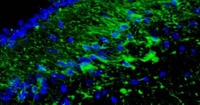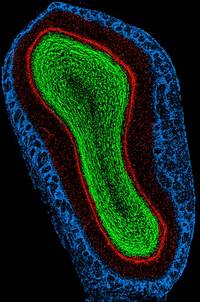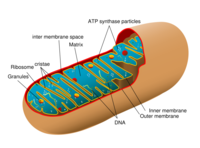A Major Breakthrough in Neurogenesis Research

I have written a lot about adult neurogenesis, because it is so incredibly important.
When most of us were in school were taught that the brain is a static structure. That you are born with a certain number of neurons, that constitutes your neural “stash.” And after the age of five you would lose a hundred thousand neurons a day, and if you drank too many martinis it would be two hundred thousand a day. “Facts” and figures repeated from one textbook to another for fifty years. And quite wrong.
Ten years ago it was discovered that there are neural stem cells in the hippocampi of adult rodents. A study published in 1998 provided some evidence that neurogenesis takes place in the adult human hippocampus, but the idea that neurogenesis takes place in adult humans has remained contentious.
Now, an advance online publication on the website of the journal Science provides evidence that neurogenesis may also occur in the olfactory bulb of the human brain.
The whole article, including the pictures is available here. The picture at the top of this article shows new cells appearing in the olfactor bulb.
The investigators examined the rostral migratory stream (RMS) which is the main pathway by which newly born cells from the subventricular zone (SVZ) reach the olfactory bulb in rodents. The researchers discovered that there is a human RMS containing neuroblasts, a.k.a. neural stem cells.

(This is a rat olfactory bulb)
Maurice Curtis and his colleagues examined the brains of cancer patients who had recently died, after having been previously injected with bromodeoxyuridine (BrdU), a chemical that is incorporated into newly synthesized DNA. Cell biologists and oncologists have used the method for years to visualize and monitor the growth of tumors. The researchers found BrdU-positive cells in the olfactory bulbs of the patients’ brains, indicating that they contained newly-generated neurons.
The team then used antibody staining to show that the neuroblasts begin to differentiate into olfactory neurons while migrating through the rostral migratory stream. Upon arriving at the bulb, the cells continued to differentiate, forming mature olfactory neurons.
The patients whose brains were examined were between 38-70 years of age, so the findings show that neurogenesis may occur throughout the duration of the human lifespan. The function of these newly generated cells is unclear, but they may be involved in recognizing and remembering new smells in the later years of life.
The researchers also have preliminary unpublished data that the stem cells not only migrate to the olfactory bulb, but also leave the RMS and migrate into the basal ganglia and cerebral cortex. This is significant, because parts of the basal ganglia degenerate in movement disorders such as Parkinson’s Disease, and specific regions of the cortex degenerate in Alzheimer’s. The possibility that stem cells enter these regions from the RMS could therefore provide a means for developing new treatments for neurodegenerative diseases.
So although at the moment new neurons are only known to be created in a small number of ancient structures in the brain, but that may well change, since the cells are marching over there from regions around the ventricles. After all, why would Nature, the Universe or God have left neural stem cells sitting there unless it was for a good reason? And if adult neurogenesis can be demonstrated in other parts of the brain, then what? An end to the stem cell debates? If the stem cells are already present in the brain, the effort can be directed toward activating and directing them. Could we continue generating new neurons to stave off the dementing illnesses, or is that just science fiction?
The answer is that science fiction is fast becoming science fact. This research will need to be replicated, but I know of several other labs that have already accumulated some similar data to this new paper in Science.
Dexterity and Strategy
I am a great believer in trying to do new things to stimulate latent abilities in the brain: there is more and more evidence about how valuable that can be.
Here is a very simple little game that can provide you with an excellent neurological work out.
Do not try it for more than a minute or two, or you might get repetitive strain injury or a psychological meltdown!
Cognitive Brain Health Test
One of the blogs that never fails to provide me with some food for thought is Zack Lynch’s Brain Waves.
He has just alerted his readers to a very interesting resource.
The Brain Resource Company launched a free, confidential, 40-minute cognitive brain test in partnership with the Alliance for Aging Research. The company is offering the test at no cost until May 14, 2007.
When you first click on the link for the test, you are taken to a page on Brain Health with a great many links.
I am extremely familiar with the literature on the brain, aging and cognition. So on your behalf, I passed a critical eye over the material. I was really pleased with it. I have one or two very minor quibbles, and one or two of the links are not working yet, but overall the information is excellent and above all reliable.
One thing about doing the test is that it needs for you to be using Windows. So we Macintosh users are left out in the cold. But the test is well worth doing, so if you are a Macintosh user, you might want to see if you can borrow a Windows machine for an hour.
“Most people would sooner die than think; in fact they do so.”
–Bertrand Russell (Welsh Mathematician, Philosopher, Pacifist and, in 1950, Winner of the Nobel Prize in Literature, 1872-1970)
“The longer I live, the more beautiful life is.”
–Frank Lloyd Wright (American Architect, 1867-1959)
Spicy Foods as Cancer Killers

Several news services have picked up a very important piece of research in the February 16th issue of the journal Biochemical and Biophysical Research Communications.
In a nutshell, they have shown that capsaicin, an ingredient of jalapeno peppers, triggers cancer cell death by attacking mitochondria, the energy producing organelles in the cell. Some of the reports were a little confused and confusing and also missed out some critical pieces.
So first, a bit of revision, this is a graphical representation of what a mitochondrion looks like:

The mitochondrion is the primary producer of energy in the cell, converting molecules derived from food or stores into adenosine triphosphate (ATP) and several other less important molecules. ATP is the energy “currency” throughout the body. In recent years we have discovered that there are a number of diseases that are a result of faulty mitochondrial metabolism.
One of the biggest problems about most forms of chemotherapy for cancer is that the treatments often damage normal cells as well as the malignant ones. Therefore a great deal of research has aimed at identifying differences between normal and malignant cells.
Over the last ten years, increasing evidence has shown that mitochondrial dysfunction is a key feature of many types of cancer as well as part of normal aging. This has lead to the idea that we might have a new therapeutic target if cancer cell mitochondria are different from those in normal cells.
This new study showed that the family of molecules to which capsaicin belongs, the vanilloids, bind to proteins in the cancer cell mitochondria to trigger apoptosis – programmed cell death – without harming surrounding healthy cells. Capsaicin was tested on cultures of human lung and pancreatic cancer cells.
As the lead researcher Timothy Bates has said, “We believe that we have in effect discovered a fundamental ‘Achilles heel‘ for all cancers.”
This is extraordinarily interesting, not least because capsaicin is already in use for the topical treatment of peripheral neuropathy and some inflammatory conditions of the skin including psoriasis. The amount of capsaicin used in the experiments was similar to amounts that could probably be ingested safely. So now the next step if to see whether these observations can be translated into a viable treatment option for cancer, and if so, which types.
What the research does not say is that eating a lot of spicy food will help prevent or treat cancer.
The reports that I have seen have failed to mention that one of the reasons for doing this research was that some spices have been used in traditional Chinese and Indian medicine for many centuries for the treatment of several conditions, and some of the investigators are engaged in the Nottingham UK–China Collaboration on Complementary and Alternative Medicine.
How many more treasures are waiting for us in the archives of traditional medicine?
And how many have already been lost as plant and animal species become extinct?
Healthy Aging
I have talked about the small number of simple steps that can dramatically reduce your risk of getting congnitive decline as your get older and some new evidence to show the benefits of non-drug treatments for dementia. I am pleased to say that my conclusions have just been supported by an editorial in the Journal of the American Medical Association.
I would like to let you know about another great resource: the International Council on Active Aging (ICAA) which has produced a great package of action items that are all rooted in good quality scientific research. The list is very similar to the ones that I have created for you here, and are very precise.
- Invest in good shoes and socks
- Play games
- Walk
- Increases your physical activity
- Do exercises to improve your balance
- Get regular eye checks, not only for corrective lenses, but to be checked for early evidence of diabetes or high blood pressure
- Seek out friends family and neighbors
- Modify your diet toward a "Mediterranean" one
- Laugh
- Get enought sleep
Whatever your age, I urge you to spend a few minutes working on a simple plan that will fit your schedule: your mind and body, family and friends will thank you forever.
Brain Gain

We have previously discussed how a relatively small number of strategies can dramatically reduce your risk of cognitive decline as you get older.
Our recommendations are firmly buttressed by a most important article available for free download at the website of the Journal of the American Medical Association.
We already knew that cognitive training can improve cognitive abilities in older adults but nobody had established the effects of cognitive training on everyday function.
Sherry Willis of Pennsylvania State University led a team of scientists that followed a group of 2,832 adults, aged 65 and older -mean age 73.6 years – who were still living independently between 1998 and 2004. The seniors came from all walks of life, races, and parts of the country, including Birmingham, Alabama; Detroit, Michigan; Boston, Massachusetts and three other major cities. They all had one thing in common when the study commenced: they had no signs of cognitive impairment.
The researchers divided them into four groups of roughly 700 each: three groups that would receive training in either memory (verbal episodic memory), inductive reasoning or speed of processing (visual search and identification) with 4-session booster training at 11 and 35 months after training, and one that would serve as a control.
The memory training program consisted of mnemonic strategies for remembering word lists or texts, such as associating various words, visualizing them or organizing them in specific ways. Reasoning training taught the participants how to spot the pattern in a series, such as “a c e g i… .” The researchers boosted the subjects’ processing speed via practice, practice, practice in identifying an object on a screen after increasingly short exposures.
Over the course of the next five years the researchers asked participants to appraise their skills and to report whether the training had helped with everyday tasks. They also independently evaluated the subjects’ skills in things like finding items in a medicine cabinet. After training, 87 percent of the speed trainees, 74 percent of the reason trainees and 26 percent of memory trainees showed immediate improvement. That advantage over their untrained peers persisted over the next five years.
The training seemed to largely offset the cognitive decline suffered by nearly all of the controls as the years wore on. By the fifth year, significant skill gaps had opened between the people who had done the training and their untrained peers.
It is not enough to continue to do the crossword or sudoku puzzles. The brain must be continually stretched and challenged. It seems that to drive this effect, you have to practice things that you don’t like or things you don’t regularly practice.
Many of us have spent years working on new training strategies, and this research shows just how valuable cognitive training can be for all of us.
Genes, Environment and the Brain

We recently looked at the worrying suggestion that environmental toxins could, in susceptible individuals, be contributing to the apparent increase in autism over the last three decades.
There is increasing evidence that there are complex genetic and environmental interactions that contribute to abnormal aging and neurodegenerative disorders like Alzheimer’s, Parkinson’s and Huntington’s diseases.
A new study from Duke University Medical Center in Durham, North Carolina, has done more to dissect this interaction. They collected information on 1136 consecutive patients who presented to the Joseph and Kathleen Bryan Alzheimer Disease Research Center. They showed possible significant contributions of toxic environmental and occupational exposures to pathological aging in 21% of the patients, and interactions of these exposures with common genetic polymorphisms that affect cell injury and inflammation. They found a series of genes that could partially account for differences in the type of cognitive problems that people experience, the age at which they developed them as well as the rate of progression.
The researchers targeted three genes in particular – apolipoprotein E, alpha-1-antitrypsin and the hemochromatosis gene. All three are expressed in the liver and in macrophages: cells that play a critical role in immune responses, inflammation and the body’s response to stress and infections. The first two genes are particularly involved in the metabolism of lipids and the third in the balance of iron and trace minerals. This ties in with another observation. Many chronic illnesses are associated with anemia. It is now thought that this also is a defensive reaction. Not to chronic illness, but to the problem that was far more common during evolution, and that was infection. The liver pulls iron out of the circulation so that bacteria cannot use it for their own growth. This is one of a number of adaptive responses that I discuss in the book and CD series, Healing, Meaning and Purpose.
But it was also clear form this new study that genes were not the only factor. I have spoken before about the small number of strategies that can dramatically reduce our risk of developing Alzheimer’s disease. The authors of this study agree about the importance of factoring in environmental factors including, alcohol use, nutritional deficiencies and sleep and mood disorders, all of which can have an impact on cognition.
This study is yet another step toward clarifying the role of genes, inflammation and cell injury in the development of degenerative changes in the brain.
While pharmacologists can use this information to help devise new ways to protect your brain, you can use it immediately. There is a range of behavioral and dietary strategies that can reduce the burden of inflammation in the body. I shall write about some of them in articles and an eBook in the near future.
We do not know whether these strategies can reduce the risk of Alzheimer’s and Parkinson’s diseases, but there are some intriguing suggestions that they can.
Memory Molecules
There are still a great many mysteries about memory:
- The molecules in neurons are constantly changing, as are many of the connections between cells. So how can memory be maintained for a lifetime in an environment that is in a constant state of flux?
- Why is it that you can remove large regions of the brain yet memories are not lost? Even in the late stages of Alzheimer’s disease, some long-term memories are maintained even when much of the brain is taken over by plaques and tangles.
- How much memory is there outside the brain and in the body?
- Is some memory maintained not in the brain itself but in fields associated with the body?
Gradually some questions are being answered not just by technology, but by asking new questions and bringing new types of expertise to bear on these problems.
A very interesting new study was published last week in the Journal of Neuroscience. The paper was not by neurologists, but by two mathematicians from the Brain Institute at the University of Utah. Their research suggests that memories are held in our brains because certain proteins serve as anchors, holding other proteins in place to strengthen the connections between nerve cells known as synapses. The anchors keep proteins in place, and these proteins in turn determine how strong a synapse is. And the strength of the synapse is a key to forming and retaining memories.
Synapses function by electrical activity in a neuron releasing a chemical neurotransmitter that affects another neuron or an organ.
One of the primary neurotransmitters involved in learning and memory is called glutamate, that binds to a number of receptors. But the most important for memory are the "AMPA receptors" that are embedded in the receiving ends of neurons. The AMPA receptors are held in place by special scaffolding molecules.
The mathematicians were able to make several predictions about the way in which AMPA receptors stay in place and how repeatedly learning something strengthens the connections between neurons.
The key to learning and remembering is anchoring AMPA receptors on our neurons.
I went into the technical side a bit, because this finding may help us get closer to understanding what goes wrong in Alzheimer’s disease.
It also ties in with some other research out this week in the journal Neuron. A team from the Univesity of Oxford has been trying to work out why adults may find learning more difficult than children. The young learn things more easily, but older brains stiore information more efficiently. They also focused on synapses, and seem to have found the mechanisms involved.
Young brains have many "silent" synapses that don’t do anything unless called upon to learn something. Older brains have to reuse synapses that have already been used, boosting the strength of connections with increased amounts of neurotransmitters.
So as we get older, our brains adopt different strategies for learning new material, and we should get ever better at organizing and integrating information.
That also fits with the strategies that we have used for improving people’s ability to learn and remember. We use connections as in Mind mapping, multiple sensory associations inclusing music, color and smells, and a sophisticated method for asking constant questions to see if new information fits with material that we have already asimilated.









